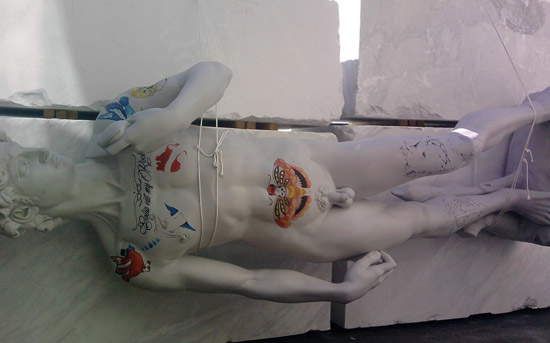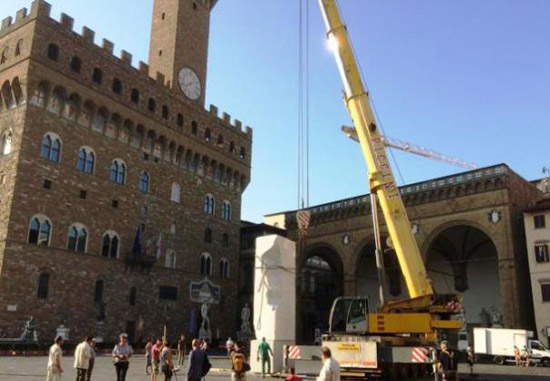The return of the superfluous: the bad initiatives of the Michelangelo Week in Florence
For some time now in Italy there has been the baleful custom of celebrating anniversaries concerning famous artists (births, deaths, realizations of famous works of art and whatnot) with the most atrocious gimmicks, which in the intent of those organizing them should pay homage to the illustrious dedicatee, but which in reality turn out to be what they are, namely embarrassing shenanigans that would probably throw the artist, if still alive, into the darkest despair. And it is peculiar that the city identified by most as the home of beauty, namely Florence, is the one that perhaps more than any other sees the flourishing of events far removed from the concepts of elegance and quality.
Just as an example, it takes courage to look positively at the Michelangelo and Pollock exhibition organized last year in Palazzo Vecchio (we are talking, of course, about Florence) on the occasion of the 450th anniversary of Michelangelo Buonarroti’s death. All this while the Crucifix of Santo Spirito, one of Michelangelo’s greatest masterpieces, was making its way to Rome to be displayed in a less than inspiring exhibition. And, again to stay in Tuscany, how can one not feel a rush of disgust thinking about the farce of Caravaggio’s bones devised for the 400th anniversary of the Lombard painter’s death? And perhaps it is appropriate to stop here. But the levers of celebratory marketing are back these days to target poor Michelangelo, against whom there seems to be a certain commercial doggedness going on. So here it is that the City of Florence, in collaboration with the Mercato Centrale, has come up with this year’s"Michelangelo Week": a week of events from July 14 to 19 to commemorate, for the umpteenth time, Michelangelo’s passing, on the anniversary of the artist’s solemn funeral on July 14, 1564. Curated by Sergio Risaliti: yes, the same one who was in charge of the Michelangelo and Pollock exhibition.
Now, we can pass over the fact that in order to exploit the name of Michelangelo to the last crumb (which, moreover, shows a very poor inventiveness on the part of Dario Nardella’s administration) they even take the artist’s funeral as a pretext. And we can also pass over the fact that among the highlights of “Michelangelo Week” is the display of Luciano Massari’s Jersey Shore-style (but with less taste) tattooed David, which we in Carrara have already had to endure on the occasion of Marble Weeks in 2013: the good thing is that here at the seaside we got rid of it, so now it’s only fair that you, dear Florentine friends, should enjoy the tamarack David a little. So maybe you will try to explain to us the meaning of this work, because here after two years we still haven’t found it.
 |
| The tattooed David when it was exhibited in Carrara. |
What is intolerable, however, is the attempt to rewind art history at will, to bend the subject matter to the purposes of the event: in fact, yesterday, in Piazza della Signoria, a huge block of marble (“the same size as that extracted from the mountains of Carrara in the 15th century,” assures the City of Florence) was placed in which the right arm, already finished, of David can be distinguished. Now, we at Finestre sull’Arte have long been saying that in order to make the relationship between Italians and their historical-artistic heritage stronger, we need more education, more quality, more culture. Initiatives like the marble block initiative clash head-on with these concepts. In this case, for at least three reasons.
 |
| The laying of the marble block in Piazza della Signoria. Photo by firenzepost released under a Creative Commons license. |
Meanwhile, presenting to the public a block of marble with the arm already finished is completely misleading: Michelangelo did not work directly on the block, but on a sculpture already sketched out by Agostino di Duccio first (in 1464) and then by Antonio Rossellino (in 1476). The two artists were commissioned well before Michelangelo to carve a colossal David from the block, but they gave up in the face of the difficulties involved in working on such a large figure. Michelangelo thus found himself working on a figure that already resembled that of a man. Not least because, in order to facilitate transportation from Carrara to Florence, Agostino di Duccio had in all likelihood already roughly sculpted an initial human silhouette. Michelangelo was therefore called “ad faciendum et perficiendum et perfecte finiendum quendam hominem, vocatum gigante, abozatum, brachiorum nove ex marmore [...] olim abozatum per magistrum Augustinum,” or “to create, execute and completely finish the man, called giant, sketched, nine arms high, in marble, once sketched by master Agostino (di Duccio, nda),” as stated in the contract of allocation between the artist, the consuls of the Wool Art (who financed the undertaking) and the Workers of the Cathedral of Santa Maria del Fiore (the destination of the sculpture) signed on August 16, 1501. The document also makes us aware about the fact that the Florentines of the time called “Giant” the sculpture that had remained unfinished for decades in the Duomo’s construction site: this gives us an idea that it must have already had human features. And what name did the creatives of “Michelangelo Week” think to give the marble block in Piazza della Signoria? “Giant,” in an obvious burst of originality.
The second reason: we have long talked on this site about Carrara’s serious environmental problems, mostly resulting from marble quarrying, conducted at an increasingly unsustainable pace. This block, which certainly would have looked better still attached to the mountains from which it was quarried, is but one more symbol of the disintegration of the Apuan Alps: inside that block, we do not see the arm of David. We see there the profile of our mountains, which is lowering a few centimeters day by day. We see us the quarrymen who often sacrifice their lives because of others’ lust for profit. We see our waterways and our air prey to pollution. And we see us, precisely, an activity that has almost no returns on the city of Carrara, which is among the poorest in northern Italy. Effects that hurt even more when we think that this block was intended for ephemeral use, and that it has nothing to do with Michelangelo’s art, whose underlying idea it cannot even explain.
Yes, because the third reason is related precisely to Michelangelo’s conception of art. Writing to the man of letters Benedetto Varchi, Michelangelo said that “I mean sculpture that which is made by dint of levare,” echoing Leon Battista Alberti ’s idea that sculptors are those who work “only by levar via, as that by taking away that which is superfluous in said matter, they sculpt, et make to appear in marble a form or figure of man, which was there before hidden, et in potentia.” For Michelangelo, then, sculpting means eliminating the superfluous. It took the city administration of 2015 Florence to bring back to the city that superfluity that Michelangelo instead removed. There could not have been a more apt metaphor to define this initiative: the return of the superfluous. I wonder what Michelangelo would think if he saw something like this.
Warning: the translation into English of the original Italian article was created using automatic tools. We undertake to review all articles, but we do not guarantee the total absence of inaccuracies in the translation due to the program. You can find the original by clicking on the ITA button. If you find any mistake,please contact us.



























